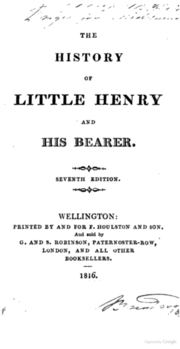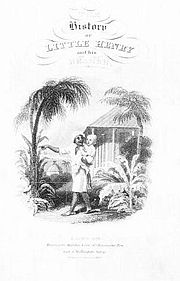
The History of Little Henry and his Bearer
Encyclopedia

Mary Martha Sherwood
Mary Martha Sherwood was a prolific and influential writer of children's literature in 19th-century Britain...
. It was continuously in print for 70 years after its initial publication and was translated into French
French language
French is a Romance language spoken as a first language in France, the Romandy region in Switzerland, Wallonia and Brussels in Belgium, Monaco, the regions of Quebec and Acadia in Canada, and by various communities elsewhere. Second-language speakers of French are distributed throughout many parts...
, German
German language
German is a West Germanic language, related to and classified alongside English and Dutch. With an estimated 90 – 98 million native speakers, German is one of the world's major languages and is the most widely-spoken first language in the European Union....
, Spanish
Spanish language
Spanish , also known as Castilian , is a Romance language in the Ibero-Romance group that evolved from several languages and dialects in central-northern Iberia around the 9th century and gradually spread with the expansion of the Kingdom of Castile into central and southern Iberia during the...
, Hindustani
Hindustani language
Hindi-Urdu is an Indo-Aryan language and the lingua franca of North India and Pakistan. It is also known as Hindustani , and historically, as Hindavi or Rekhta...
(1814; 1873), Chinese
Chinese language
The Chinese language is a language or language family consisting of varieties which are mutually intelligible to varying degrees. Originally the indigenous languages spoken by the Han Chinese in China, it forms one of the branches of Sino-Tibetan family of languages...
, Marathi
Marathi language
Marathi is an Indo-Aryan language spoken by the Marathi people of western and central India. It is the official language of the state of Maharashtra. There are over 68 million fluent speakers worldwide. Marathi has the fourth largest number of native speakers in India and is the fifteenth most...
(1853), Tamil
Tamil language
Tamil is a Dravidian language spoken predominantly by Tamil people of the Indian subcontinent. It has official status in the Indian state of Tamil Nadu and in the Indian union territory of Pondicherry. Tamil is also an official language of Sri Lanka and Singapore...
(1840), and Sinhalese. Telling the story of a young British boy who, on his deathbed, converts Boosy, the Indian man who has taken care of him throughout his childhood, the book is dominated by imperialistic
Imperialism
Imperialism, as defined by Dictionary of Human Geography, is "the creation and/or maintenance of an unequal economic, cultural, and territorial relationships, usually between states and often in the form of an empire, based on domination and subordination." The imperialism of the last 500 years,...
and evangelical
Evangelicalism
Evangelicalism is a Protestant Christian movement which began in Great Britain in the 1730s and gained popularity in the United States during the series of Great Awakenings of the 18th and 19th century.Its key commitments are:...
themes.
Style
Sherwood's tale blends the realisticLiterary realism
Literary realism most often refers to the trend, beginning with certain works of nineteenth-century French literature and extending to late-nineteenth- and early-twentieth-century authors in various countries, towards depictions of contemporary life and society "as they were." In the spirit of...
with the sentimental
Sentimentality
Sentimentality originally indicated the reliance on feelings as a guide to truth, but current usage defines it as an appeal to shallow, uncomplicated emotions at the expense of reason....
and introduces her readers to Hindustani words and descriptions of what she felt was authentic Indian life. As children's literature scholar M. Nancy Cutt explains, "with this work, the obituary tract (which invariably stressed conversion and a Christian death) had assumed the colouring of romance".
Themes

Threatened by the specter of British children being raised by Indian "bearers" and "dhayes", Regaignon argues, Sherwood provides her British readers with stories showing the hero and heroine drawing strength and ultimately imperial domination from those very ties—"in Sherwood's hands, threats to imperial identity ultimately reinforce it." Both Henry and Lucy teach their caretakers, reversing the power dynamic initially established in the story. Henry even turns into a Christ
Christ
Christ is the English term for the Greek meaning "the anointed one". It is a translation of the Hebrew , usually transliterated into English as Messiah or Mashiach...
figure, sacrificing his life for Boosy's conversion.
In addition, Sherwood's "stories are meant to inspire their readers to missionary action". In Little Henry, Henry's death is what prompts Boosy's conversion. The last line of the book urges its readers to follow Henry's example: "Little children in India, remember Henry L—, and go and do likewise" (emphasis in original). However, as Regaignon argues, Henry's conversion is also "a kind of synecdoche for the shift of British imperial attitudes from orientalism to anglicization that occurred in the first decades of the nineteenth century". At the time that Little Henry was published, Evangelicals were gaining political influence in Britain; Warren Hastings
Warren Hastings
Warren Hastings PC was the first Governor-General of India, from 1773 to 1785. He was famously accused of corruption in an impeachment in 1787, but was acquitted in 1795. He was made a Privy Councillor in 1814.-Early life:...
, the former governor-general of Indian, had just been impeached
Impeachment of Warren Hastings
The Impeachment of Warren Hastings was a failed attempt to impeach the former Governor-General of India Warren Hastings in the Parliament of Great Britain between 1788 and 1795. Hastings was accused of misconduct during his time in Calcutta particularly relating to mismanagement and personal...
; and the Charter Act of 1813 newly allowed missionary activities in India. Not only were its readers receptive to its message, it "helped to make the conviction that English superiority to and dominance of other cultures was a matter of moral truth appealing and persuasive to generations of children".
Using a postcolonial
Postcolonialism
Post-colonialism is a specifically post-modern intellectual discourse that consists of reactions to, and analysis of, the cultural legacy of colonialism...
analysis, Nandini Bhattacharya emphasizes the complex relationship between Sherwood's evangelicalism and her colonialism
Colonialism
Colonialism is the establishment, maintenance, acquisition and expansion of colonies in one territory by people from another territory. It is a process whereby the metropole claims sovereignty over the colony and the social structure, government, and economics of the colony are changed by...
. She argues that Sherwood's evangelical stories demonstrate the deep colonial "mistrust of feminized agency," represented by a dying child in Little Henry and his Bearer. Henry "subvert[s] the colonialist's fantasy of universal identity by generating a subaltern identity that mimics and explodes that fantasy." But, ultimately, Bhattacharya argues, Sherwood creates neither a completely colonialist text nor a subaltern
Postcolonialism
Post-colonialism is a specifically post-modern intellectual discourse that consists of reactions to, and analysis of, the cultural legacy of colonialism...
text; the deaths of children such as Henry eliminate any possibility for an alternative consciousnesses to mature.
Publication history
Written in 1810 when Sherwood was living in India and published in England in 1814, Little Henry went through 18 printings between 1814 and 1824 alone. It appeared every three years (on average) until 1883. The book was also popular in the United States in the first half of the nineteenth century, until 1852 when Uncle Tom's CabinUncle Tom's Cabin
Uncle Tom's Cabin; or, Life Among the Lowly is an anti-slavery novel by American author Harriet Beecher Stowe. Published in 1852, the novel "helped lay the groundwork for the Civil War", according to Will Kaufman....
superseded it. One scholar has suggested that Harriet Beecher Stowe
Harriet Beecher Stowe
Harriet Beecher Stowe was an American abolitionist and author. Her novel Uncle Tom's Cabin was a depiction of life for African-Americans under slavery; it reached millions as a novel and play, and became influential in the United States and United Kingdom...
used Henry as a model for "Little Eva" in her novel, but Regaignon argues that racial histories underlying the two countries are too different for this influence to make much sense.
In 1842 Sherwood published The Last Days of Boosy, a sequel to Little Henry. As Regaignon explains, it is "markedly different" in "style, tone, and doctrine" from the previous book. It does not cite the Bible as frequently and God is depicted much less sternly. While Little Henry is part of what Cutt has referred to as Sherwood's "Evangelical period", The Last Days of Boosy is not.
External links
- The History of Little Henry and his Bearer (1816, 7th edition) at Google Books

